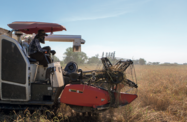Faced with weak investment inflows and growth rates well behind that of GDP, Myanmar’s agriculture industry is being targeted by the government and international agencies for an overhaul aimed at lifting productivity and returns.

In late April the Ministry of Agriculture, Livestock and Irrigation (MALI) announced it was in the process of drafting a development strategy for the sector.
The main targets of the blueprint are to improve sectoral monitoring, increase production and raise the sector’s competitiveness, officials said.
Authorities hope to accomplish these goals by establishing stronger links between the public and private sector via 42 programmes and 263 plans of action.
Being developed with input from the Asian Development Bank, the UN Food and Agricultural Organisation, and Livelihoods and Food Security Trust Fund, the MALI expects to finalise and publish the new strategy in July, with extensive consultations with stakeholders to be held both this month and next.
Cooling growth
The new strategy is being developed at a time when agriculture is failing to keep up with the rest of the economy.
The sector expanded by an estimated 4.3% in 2016, according to data issued by the World Bank in mid-April. While this represented an improvement on the 3.4% growth posted in 2015 and 2.8% a year earlier, the sector continues to lag behind the broader economy, with GDP expansion hitting 6.5% last year.
This gap is forecast to persist in the medium term, with the World Bank estimating in its “Sustaining Resilience” report published last month that Myanmar’s agriculture sector will expand by around 5.4% every year through to 2019, compared to broader economic growth of 7%.
Easing credit drought
Even in its draft stage, the MALI strategy has identified some key areas where improvements need to be made to help bridge the growth gap. One of these involves improving access to credit among the nation’s farmers – an issue cited by other observers as restricting capacity development in the sector.
An Article IV Consultation released by the IMF in early February, for example, highlighted that improved access to credit was called for in the sector given the lower than expected growth recorded last year. According to the international lender, there was scope for “carefully sequenced loosening of controls on lending interest rates, supported by appropriate supervision”.
Investment shortfall
At the same time farmers have struggled to obtain appropriate financing, their industry is also having difficulty attracting significant levels of investment when compared with other leading sectors.
Although agriculture is the country’s leading employer and contributor to the economy – accounting for some 24% of GDP – it is has not drawn levels of investment that are commensurate with this high input.
Domestic investors directed MMK13.19trn ($9.7bn) into more than 1240 registered enterprises in the 12 months ending March 31, with the agriculture and livestock segment only drawing 0.38% of the total. Even with the fisheries segment factored in, this only rose to 0.91%.
By contrast, the real estate sector attracted MMK2.76trn ($2bn) of domestic investments, just under 21% of the total, according to data issued by the Directorate of Investment and Company Administration in April, with manufacturing and transport drawing MMK2.4trn ($1.7bn) and MMK2.3trn ($1.6bn), respectively.
Furthermore, of the 20m ha of agricultural land available in Myanmar, only 20% is farmed using machinery. This has contributed to the slow growth, with the government pushing for the sector’s restructuring and mechanisation as a result.
“The country is not able to fully leverage its capacity because it does not have the best machinery, nor the best quality seeds, and undertakes limited research and development." Sunil Seth, president of the Overseas Agro Traders Association of Myanmar and TATA group head in Myanmar, told OBG.
If not tackled fast, Myanmar could lose ground to competitors in African markets, such as Mozambique, Sudan and Tanzania, which can produce the same crops at a lower cost than Myanmar, according to Seth.
U Aung Zaw Oo, chairman of agricultural group Aung Naing Thitsar, also spoke of shortcomings that limited forward momentum in the industry. “There is no proper infrastructure in rural areas, whether that be storage facilities or transportation.” he told OBG.
New law lifts investment potential
To help tackle these challenges, agriculture has been identified by the Myanmar Investment Commission as one of 20 key sectors for investment prioritisation, with a new investment law introduced in April aimed at easing the route to investment for overseas companies.
Unlike previous investment acts, the new legislation covers both overseas and domestic firms. Along with income tax exemptions for investors buying into targeted sectors such as agriculture and agribusiness, there is also support for firms operating out of special economic zones being established by the state.
The fact that the new law has reduced the corporate income tax exemption from five to three years in major cities and increased it to seven years in less-well-developed areas could also help attract investors into the agriculture sector, which is largely based in rural regions.


